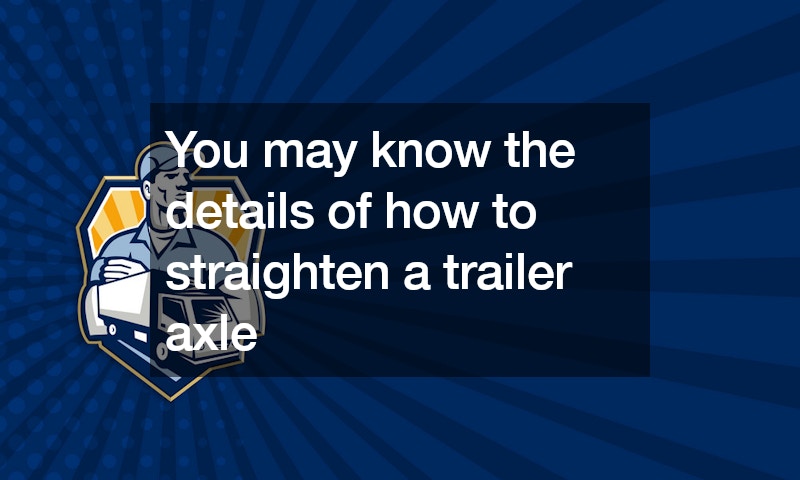Truck and trailer alignments are a crucial part of the function and safety of a trailer, so it’s a good idea to be informed of the details of any that you may be handling. You can find this information on the internet, possibly even learning about various trailer alignment tools in the process. To this end, you can search using terms like “details of regular truck & trailer wheel alignment” or even “what should big rig wheel alignment look like?” In the results, you’re sure to find a lot of beneficial information, making it easy for you to understand conversations that you may have with your mechanic in case a breakdown occurs.
With this in mind, remember that this information should be for informational purposes mainly since repairing trucks and trailers takes a lot of skill and experience. In any case, while you may know the details of how to straighten a trailer axle, you may not have every single tool or even a workable setup that you can use to get the task done. You can still take pleasure in keeping up with the project, being in a position to take part in an active conversation with an expert on the matter as they prepare to work on the truck.
Any good mechanic who specializes in big rigs should know all about big rig wheel alignment and have the necessary trailer alignment tools that they need to do a safe job. That’s because truck and trailer alignments may be a bit different from regular vehicle alignments, especially when it comes to the scale. If you drive a truck yourself, you can also benefit from learning about truck & trailer wheel alignment. Even if you have no intentions of ever actually doing it, you may enjoy finding out the details.
Even when you know how to straighten a trailer axle and more, however, note that you should never attempt to work on trailer repairs by yourself unless you get the training to do so. That’s because the information that you find online can be educational, but it won’t give you the hands-on experience that’s necessary for you to do a safe job at any rate. As the term itself implies, big rigs are huge and heavy, and this means that failure to handle them the right way can result in damage or injury. When you know the terms that you may hear in this industry, you’ll have the advantage of knowing what your mechanic is talking about any time you need to take your truck for alignment or something else.

Thanks to the internet, there is now a considerable rise in international trade. With this comes the need to transport items from airports and sea harbors to inland locations. As such, one of the most lucrative sectors now is the transport industry. Here, you will invest in a few truck trailers to haul as many bulky goods as possible to maximize your profits.
You can find the ideal trailers at a company dealing with new and used diggers for sale and other heavy machinery. While most people will base their choice of a trailer on its cost and size, it is wiser to base yours on the suspension system. A trailer’s suspension system will determine its maintenance needs, stability, and load capacity. It also impacts a driver’s safety and comfort when navigating rough terrain.
The following are the four suspension systems you can pick for your truck trailer:
Mechanical system
This system is comprised of reaction arms that will maintain the horizontal orientation of a trailer’s axles in all motions. The primary benefit of a mechanical suspension system is thus its stability even in rough terrains. Moreover, with this system, your trailer’s load distribution is kept constant even when braking. Mechanical systems are inexpensive, need little to no lubrication, and often have spring mechanisms for the reduction of trailer vibrations.
Air system
This includes inflated rubber and polyurethane bags. It is considered the best replacement for the leaf spring systems used in the past. The leaf spring suspension is no longer recommended for heavy-duty trucks. Air suspension systems allow a comfortable ride and smooth gliding over bumps. The systems also have minimal vibration that translates to reduced wear and tear and maintenance expenses. A few air suspension systems have extra axles that allow the adjusting of a trailer’s height. Low height will, for instance, improve vehicle steering, aerodynamics, and stability.
Rigid system

With this conventional option, the movement of one of your trailer’s wheels will depend on that of the others. Though not so comfortable for drivers, rigid suspension systems are inexpensive and simple. Their robustness will make them reliable for heavy loads since they will support varied axle movements. The tires will also remain perpendicular to the road when using a rigid suspension system. This generates a secure grip between the tires and the road and reduces the wear of your tires.
Bogie system
This is mostly used in RGN trailers. It allows drivers to lower a trailer’s engine position and the center of gravity. This consequently increases stability and permits the adjustment of a trailer’s height. Bogie suspensions are also associated with minimal vibrations and reduced body impact on rough terrains. These boost a driver’s comfort.
The selection of a suspension system from the above will be informed by your needed stability level, turning frequency, and the highest expected weight of your cargo. If you choose a suspension that is excessively light for your trailer, it will increase the impact damage to your vehicle. If, on the other hand, the suspension is overly rigid, it contributes to a driver’s fatigue.

